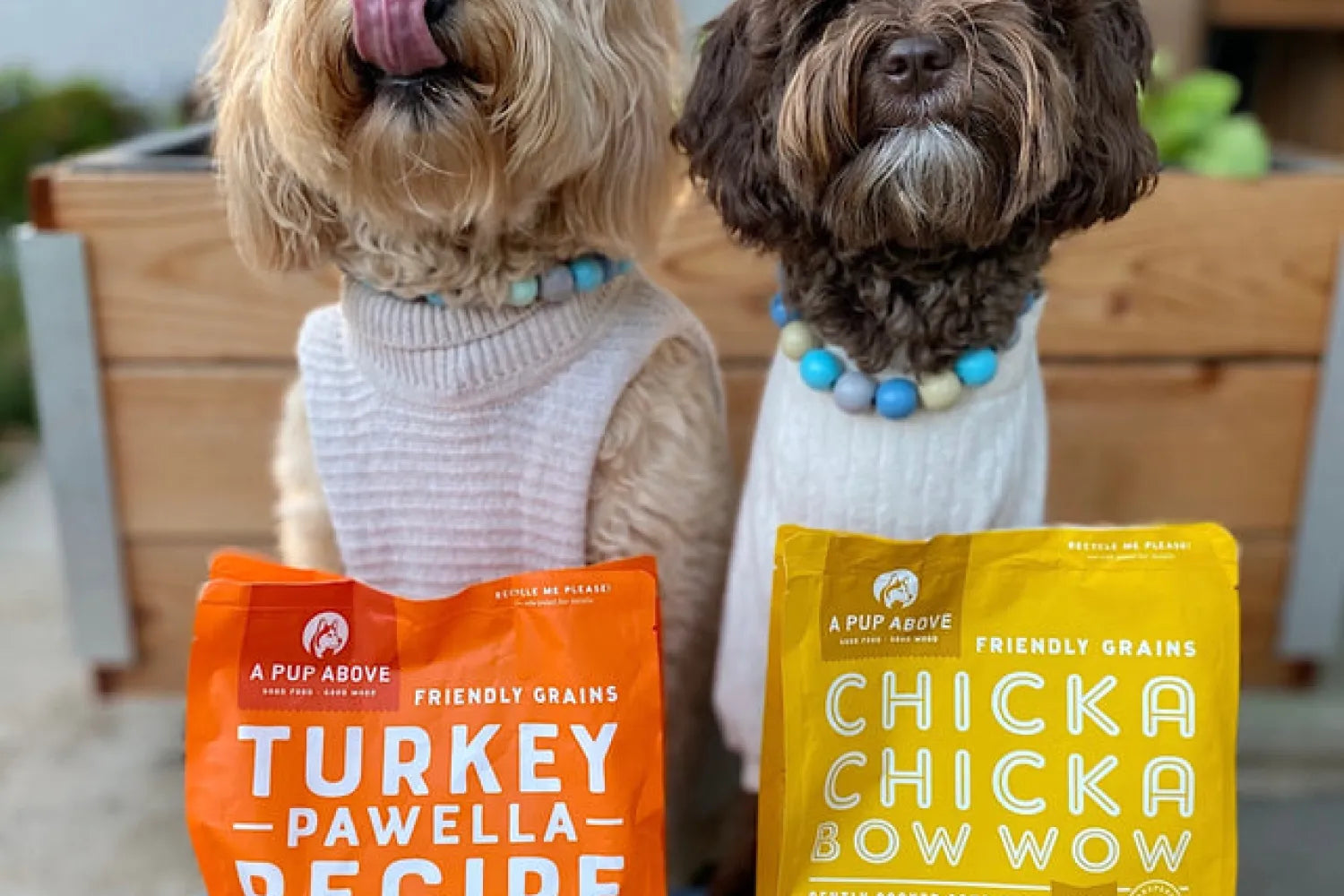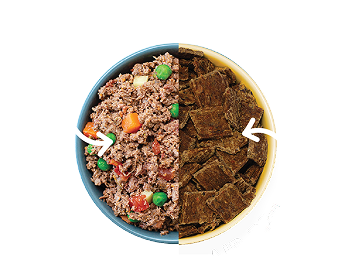
Hypoallergenic Dog Food for Sensitive Pups
Table of Contents
- What Is Hypoallergenic Dog Food?
- What Makes a Dog Hypoallergenic?
- What’s the Difference Between Grain-Free and Hypoallergenic Dog Food?
- What Is Hypoallergenic Dog Food Made Of?
- Is There a Certification for Hypoallergenic Dog Food?
- Is Hypoallergenic Dog Food More Than Just a Trend?
- How Do I Choose the Right Hypoallergenic Dog Food?
- Can Hypoallergenic Dog Food Cause Diarrhea?
- Wrapping Up
Finding the right diet can be challenging for dogs with sensitive stomachs or food allergies. Hypoallergenic dog food is designed to address these issues by providing a safe and nutritious option for pups that struggle with common ingredients.
Unlike regular dog food, hypoallergenic options focus on using high-quality, limited ingredients to minimize allergic reactions and digestive upset. At A Pup Above, with our human-grade, carefully crafted meals, we’re committed to catering to the needs of dogs with sensitive stomachs.
Understanding the benefits of hypoallergenic dog food can make a big difference in your pet's health and happiness.
What Is Hypoallergenic Dog Food?
Hypoallergenic dog food is specially formulated to reduce the risk of allergic reactions in dogs. These diets focus on using limited, high-quality ingredients that are less likely to trigger allergies, such as novel proteins (e.g., duck, lamb) and non-GMO vegetables.
By avoiding common allergens like wheat, corn, soy, and artificial additives, hypoallergenic dog food aims to provide a safer and more digestible alternative for sensitive pups. This type of food is ideal for dogs that experience symptoms like itchy skin, gastrointestinal issues, or chronic ear infections due to food allergies.
We’re taking this concept to the next level at A Pup Above by incorporating human-grade ingredients, nutritious bone broth, and superfoods like turmeric and parsley, which support joint, immune, and digestive health. Ultimately, hypoallergenic dog food can significantly improve a dog’s quality of life by reducing exposure to irritants while delivering essential nutrients.
What Makes a Dog Hypoallergenic?
While this piece is about hypoallergenic dog foods, it’s important to make the distinction between hypoallergenic dogs and the foods we feed sensitive pups.
A hypoallergenic dog is one that is less likely to trigger allergic reactions in humans. This often refers to breeds that shed minimally or have less dander, the primary allergen source for people. However, no dog is truly allergen-free; even hypoallergenic breeds can still produce dander, saliva, and urine that contain allergens. Factors like coat type, skin health, and grooming habits play a significant role in reducing allergen levels.
While hypoallergenic dogs may be a better option for allergy sufferers, it’s crucial to maintain regular grooming and cleaning routines to minimize exposure to allergens. Frequent brushing, bathing, and keeping the living environment clean can help reduce allergens further.
What’s the Difference Between Grain-Free and Hypoallergenic Dog Food?
Grain-free and hypoallergenic dog foods are often confused, but they serve different purposes. Grain-free dog food is formulated without grains like wheat, corn, or soy and is designed for dogs with grain sensitivities or allergies. However, it still contains other common allergens such as beef, chicken, or dairy, which may not address specific food sensitivities.
On the other hand, hypoallergenic dog food is specifically formulated to reduce the risk of allergic reactions by using limited, novel ingredients and avoiding common allergens. This type of food often relies on single-source proteins and carbohydrates that are less likely to trigger allergies.
For example, hypoallergenic diets may include proteins like duck or venison and carbohydrates like sweet potatoes instead of grains. The key difference is that hypoallergenic dog food targets a broader range of sensitivities, providing a safer option for dogs with specific dietary needs.
What Is Hypoallergenic Dog Food Made Of?
Hypoallergenic dog food is made with carefully selected ingredients designed to minimize allergic reactions in sensitive dogs. These formulas typically include novel proteins, such as venison, duck, or lamb, which are less common in traditional dog foods and therefore reduce the likelihood of triggering allergies.
Also, hypoallergenic foods often use limited ingredient lists to keep potential allergens to a minimum, making it easier to identify and avoid specific triggers. Carbohydrates in hypoallergenic dog food are usually derived from non-grain sources like sweet potatoes, peas, or chickpeas, which are less likely to cause adverse reactions.
High-quality versions, like A Pup Above’s Sensitive Stomach Bundle, incorporate non-GMO vegetables grown in nutrient-rich soils and superfoods like turmeric and thyme. With nutritious bone broth rich in collagen and essential amino acids, these formulas offer a complete, balanced meal that’s gentle on a sensitive dog’s system.
Is There a Certification for Hypoallergenic Dog Food?
Currently, there is no official certification specifically for hypoallergenic dog food. Unlike organic or human-grade pet food, which can be certified by organizations like the USDA, hypoallergenic dog food lacks standardized certification criteria.
This means pet food manufacturers can label their products as hypoallergenic based on their own formulations and ingredient selections, but there is no third-party validation specific to hypoallergenic claims.
That said, reputable brands often adhere to strict quality standards, such as AAFCO (Association of American Feed Control Officials) guidelines for balanced nutrition. They may also work with veterinary nutritionists to ensure their recipes are suitable for dogs with allergies.
When choosing hypoallergenic dog food, it's crucial to read ingredient labels carefully and look for brands that prioritize transparency, high-quality ingredients, and scientific formulation. Consulting with a veterinarian can also help ensure that the food is genuinely beneficial for a dog’s specific dietary needs.
Is Hypoallergenic Dog Food More Than Just a Trend?
Hypoallergenic dog food is far more than just a passing trend. It addresses a growing need among dogs with food sensitivities, allergies, and intolerances. With an increase in reported cases of allergies in dogs, many pet owners are seeking specialized diets to help manage symptoms like itching, digestive issues, and ear infections.
These foods provide a critical solution, helping to improve the quality of life for sensitive pups. While hypoallergenic dog food may have gained popularity in recent years, its focus on a few, high-quality ingredients and targeted nutrition addresses real health concerns.
How Do I Choose the Right Hypoallergenic Dog Food?
Choosing the right hypoallergenic dog food involves careful consideration of your dog’s specific needs and sensitivities. Start by consulting with a veterinarian to identify the potential allergens affecting your dog.
Look for high-quality foods that use single-source proteins, such as turkey or lamb, and avoid common allergens like beef, chicken, or soy. Check ingredient labels for transparency and choose brands that use human-grade, natural components without artificial additives. A well-researched formula, crafted in collaboration with veterinary nutritionists, will ensure that your pup gets a balanced diet tailored to their special dietary needs.
Can Hypoallergenic Dog Food Cause Diarrhea?
While hypoallergenic dog food is designed to minimize allergic reactions, it can still cause diarrhea in some cases, especially during the initial transition period. Changes in diet can disrupt your dog's digestive system temporarily as it adjusts to new ingredients.
To minimize the risk, introduce the new food gradually, mixing it with your dog's current food over several days to allow their stomach to adapt. Diarrhea can also occur if the hypoallergenic food includes an ingredient your dog is still sensitive to, which underscores the importance of selecting the right formula.
Monitoring your dog’s reaction during the transition phase is crucial; if symptoms persist, consult a veterinarian. They can help pinpoint the cause and recommend adjustments to guarantee that the chosen hypoallergenic food truly benefits your dog's digestive health.
Wrapping Up
Hypoallergenic dog food can be a game-changer for dogs with sensitivities, offering relief from allergies and promoting overall well-being. Understanding the differences between grain-free and hypoallergenic options, as well as what ingredients to look for, is essential in making an informed choice.
With careful selection, pet owners can ensure their dogs enjoy a nutritious, balanced diet that supports long-term health. Always consult with a veterinarian to tailor the best dietary plan for your pup so that they thrive on food that meets their specific needs.
Sources:
Food Allergies in Dogs: What to Know | American Kennel Club
The myth of hypoallergenic dogs (and cats) | Journal of Allergy and Clinical Immunology
Understanding Pet Food | AAFCO
Ear Infections in Dogs (Otitis Externa) | VCA Animal Hospitals
Top Stories

Why Do Dogs Lick Their Paws?

Why Do Dogs Whimper & Make Noises in Their Sleep?

Healthy Vet-Approved Homemade Dog Food Recipes

How To Cook Sweet Potatoes for Dogs






















